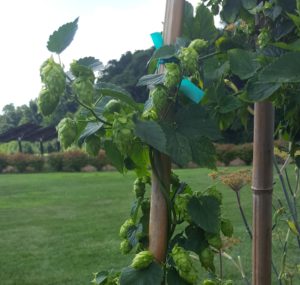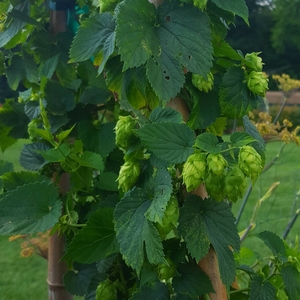
A hops bine climbs by twining around its support
Hops (Humulus lupulus) is a perennial bine used to flavor beer. The first mention of hops used in beer is from the 9th century. Hops took over as an ingredient in the 13th century when brewers realized that beer made with it did not go bad as quickly as beer made from herbal mixtures as was common prior to that time. Hops contains chemicals which act as antimicrobials to prevent spoilage.
Hops is also used medicinally to treat anxiety and insomnia. A popular treatment involves the use of a sleep pillow filled with hops which is supposed to induce sleep.
Hops is a bine rather than a vine because it has stiff, downward facing hairs which enable it to climb by twining clockwise around supports. Vines are plants that climb using suckers or tendrils to climb. Hops is dioecious. Plants are either male or female. The males are needed for pollination but not necessary if you plant to harvest and use the flowers. The flowers are borne by the female plants.
Plant your bines in full sun and rich, well-drained soil. Bines should be planted 3 to 5 feet apart. If you are starting with rhizomes, plant them at least 2 inches deep. For bines purchased in containers, dig a hole equivalent in depth with the container. Make sure that the top of the hole is the same level as the top of the soil of the root ball.

Hops bines can grow to 25 feet tall
The bines are hardy in zones 5 through 8. The first year they expend most of their energy establishing their root system which when mature can be 15 feet deep. First year bine growth is usually only to 12 feet. After that, they can grow 15 to 25 feet by June. Make sure you have a very sturdy support for them to climb on!
The bines are cold sensitive, dying back to the ground in the fall. The roots go dormant and sprout again in the spring. In the spring, when the bines reach 12 inches in height, choose 2 or 3 strong ones and prune away the rest. Train the selected bines around the supports that you have provided. In June as the summer days start to shorten, the bines stop growing vertically and start sending out side shoots where the flowers will grow. In July, trim away the foliage and side shoots from the bottom four feet of vines to promote air circulation which will prevent disease. In August when the flowers are ready for harvest, you can allow growth again in that bottom portion. This will promote growth and strength in the rhizome for next year.

Ripe cones
Most likely your hops bine will not produce any cones, as the flowers are called, in its first year. You will have to wait until the second year for flowers. The cones will be ready for harvest any time from mid-August to mid-September. It’s easy to tell if the cones are ripe. Unripe ones are still green. Ripe ones are yellow or tan and puffy. When you squeeze them, they bounce back to shape and emit the familiar fragrance. Harvesting is usually done by hand. You would be advised to wear gloves and long sleeves. The stiff hairs that enable the bines to climb can cause contact dermatitis.
You can dry your cones using a food dehydrator or by simply laying them in a single layer somewhere cool, dark and dry for 3 to 5 days. Each bine should produce between 1 and 2 ½ pounds of dried cones each.
The dried cones can be used immediately or stored in sealed plastic bags in the refrigerator. They can also be frozen.

